Type Commuter Rail Line length 10.2 km (6.3 mi) | Status Under consideration Website Cross River Rail Owner Queensland Rail | |
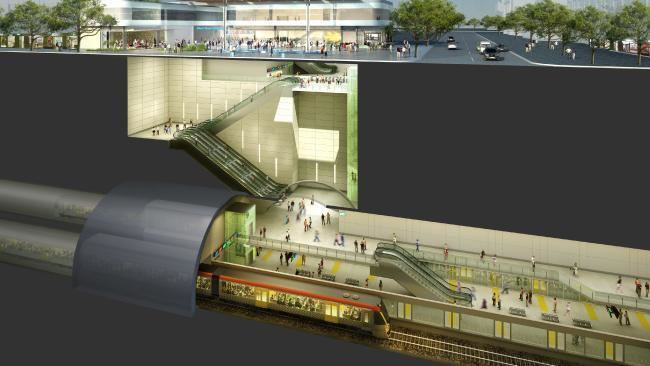 | ||
System Queensland Rail City network Terminis Bowen Hills railway station, Dutton Park railway station | ||
Cross river rail
The current Cross River Railis a proposed underground rail line through central Brisbane. In April 2016, the Queensland Government announced it would establish a Cross River Rail Delivery Authority to deliver the new project. The project replaces the planned 2013 BaT Tunnel, which in turn had replaced the original 2010 Cross River Rail proposal. The project includes just under six kilometres of rail tunnel, four new underground inner city train stations and an upgrade to the existing Exhibition station.
Contents
- Cross river rail
- Current Proposal
- 2010 Cross River Rail proposal
- 2012 revised plan
- 2013 Bus and Train Tunnel proposal
- References
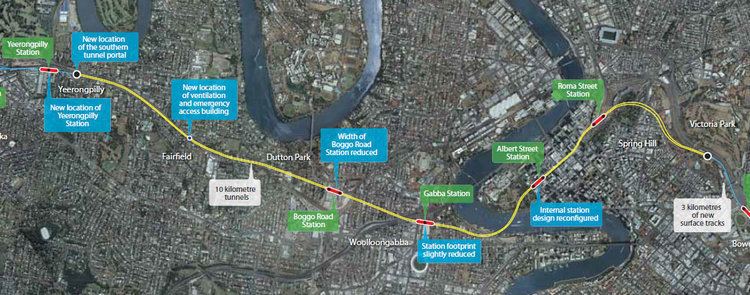
Cross river rail
Current Proposal

The current 2016 proposed 10.2-kilometre (6.3 mi) rail link involves building a new 5.4-kilometre (3.4 mi) tunnel under the Brisbane River and the Brisbane central business district, creating five new inner city station precincts, and increasing the core capacity of the rail network. The alignment will run from Dutton Park, through Boggo Road, Woolloongabba, Albert Street, Roma Street and Exhibition to Bowen Hills. No construction time table has been set but a business case is due be released in mid 2016.
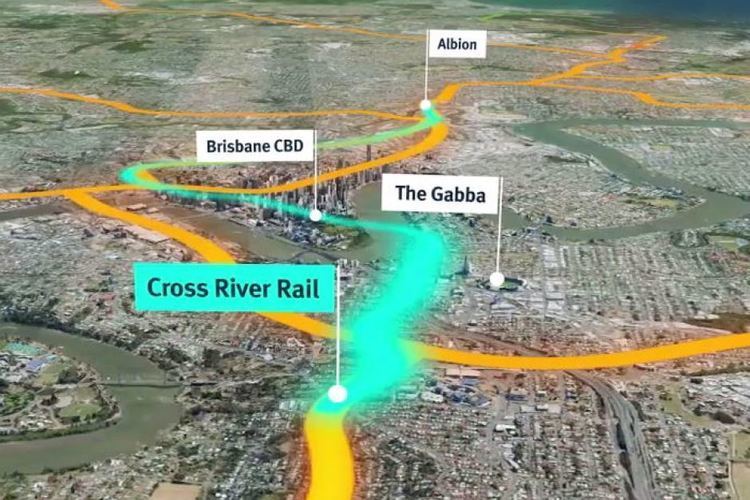
With an estimated cost of 5.2 billion it is expected to be the largest transport project ever built in Queensland. However, with the exception of a business case, no funding has been committed to the project, which will need the financial support of federal, state, local government and private interests to go ahead. Infrastructure Australia has deemed the project a national priority and warns a macroeconomic cost of $9 billion by 2031 if not built.
2010 Cross River Rail proposal
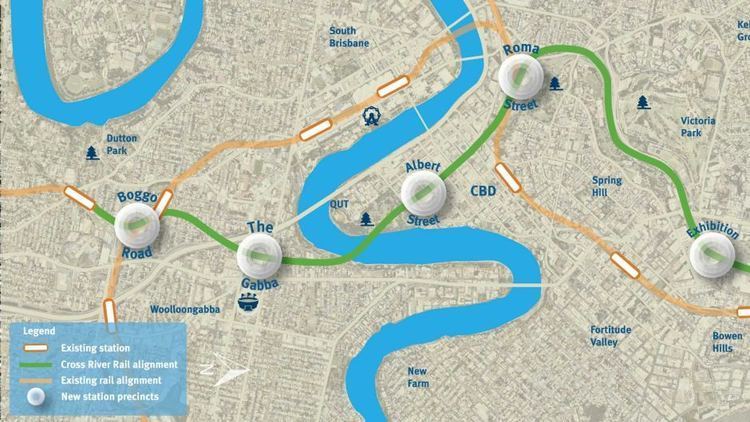
A report titled the 2008 Inner City Rail Capacity Study predicted that the demand for Brisbane peak train services would double by 2016. Between Salisbury and Dutton Park the existing line is used by freight trains traveling to the Port of Brisbane and a terminal at Acacia Ridge, and the expected rise in the number of passengers services may interrupt freight services unless a new line is built. The Merivale Bridge is the only inner-city rail crossing in Brisbane, and by 2016 it was expected to be over capacity, leading the Queensland Government to plan for this project.
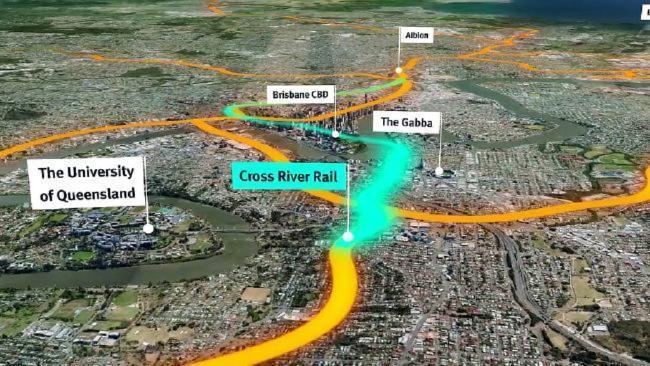
The original plans for the project were released on 11 November 2010. The project included a 9.8-kilometre (6.1 mi) tunnel, two new surface stations as well as four new underground stations. Upgrades to Moorooka railway station and Rocklea railway station were also proposed. Underground stations were proposed to include retail facilities, and a maximum of 120,000 passengers were claimed to be able to be moved during the morning peak period.
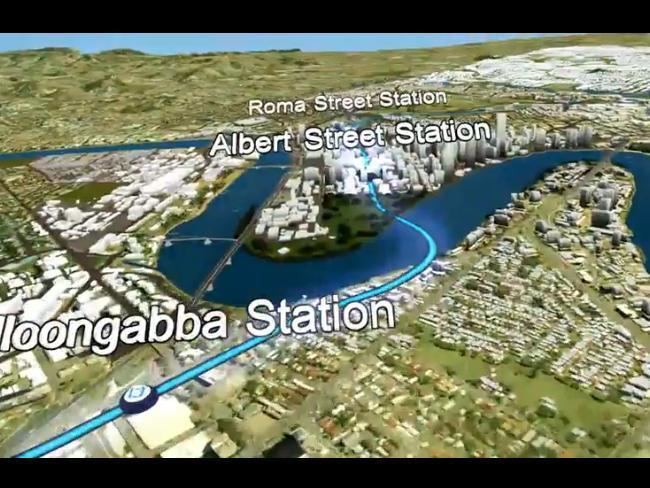
The city station was to be built under Albert Street, with two entrances and allowing for trains up to 200 m in length. Proposed stations at Woolloongabba and Exhibition were to be named "The Gabba" and "The Ekka" respectively.
Yeerongpilly was chosen as the southern portal because it had less impact on residents than a tunnel entrance at Fairfield. An entrance there would allow trains on the Ipswich railway line to use the tunnel via the Tennyson railway line. It also allowed the existing rail yards at Clapham to be used as stabling yards, negating the need to build a new storage depot for trains elsewhere.
2012 revised plan
In June 2012, the newly elected Queensland Government announced plans for a scaled down version of the project estimated to cost $4.5 billion. The revised plan excluded upgrades to existing stations and extra above-ground train lines south or north of the new tunnel. The revised plan was expected to be completed by 2020. Thirty-nine commercial properties were to have been resumed for the project, including the Royal on the Park hotel and another nine properties in the central business district. One hundred and five residential properties at Yeerongpilly were to have been resumed for the expansion of the Yeerongpilly railway station.
2013 Bus and Train Tunnel proposal
In November 2013, the Queensland Government announced a revised plan for the BaT (Bus and Train) project as an alternative to the previous Cross River Rail proposal. The revised plan involved a 14.8m external diameter (13.5m internal diameter) 5.4 kilometres (3.4 mi) tunnel to accommodate both a dual track rail line on the lower level and a two lane busway above. The cost was expected to be $5billion with construction proposed to start in 2015 and completion in 2021. Citytrain patronage is quoted as having increased at an annual average of 3.4% between 2006 and 2012, compared to an average annual population increase of 2.4% over the same period, confirming forecasts that the Merivale Bridge will reach capacity some time between 2016 and 2021.
The proposal commenced in the vicinity of Dutton Park station, with two new underground stations at Woolloongabba (adjacent to The Gabba) and George Street (in the CBD) adjacent to a proposed casino redevelopment site. The balance of the proposal involved the previously proposed underground station at Roma Street and the line connecting to the Exhibition line near Bowen Hills. The Underground stations were to also be busway stations. The southern end of the busway was proposed to connect directly to the existing Eastern Busway, with the northern end then proposed to connect to the Northern Busway via a bridge over the railway and adjacent Inner City Bypass motorway.
The stations were proposed to have 175 metre platforms to cater for future seven carriage trains, with the peak hour headway of 2.5 minutes between trains giving a notional capacity of 24 trains per hour in each direction. This was proposed to facilitate an increase in Gold Coast line services by 80% when it opened, and was also stated as catering for the 'Hillcrest (New Beaudesert) line by 2031'. That proposed line involves converting the existing standard gauge line from the Acacia Ridge freight terminal (just south of Salisbury station) to dual gauge. Hillcrest is a suburb west of Browns Plains and north of Greenbank. The standard gauge line passes west of Beaudesert on its way to the New South Wales border, and re-establishment of the station at Bromelton may be what is intended by the term 'New Beaudesert line'.
No surface property resumptions were required under this revised plan. Dutton Park station was proposed to be closed, as it would need to be demolished as part of the project and the government stated that its patronage level of ~150 passengers per peak hour didn't justify the $150m cost to rebuild the station. Following public objections, particularly to the proposed walkways from Park Road station, 800 metres away (proposed to provide replacement access to the Princess Alexandra Hospital, the major facility adjacent to Dutton Park station), the government reversed its decision.
The George street station was proposed to be built 48 metres below 63 George Street building on the corner of George and Mary streets. The George Street building, which houses many state government departments, was to be demolished. The Woolloongabba station was to be 38 metres below surface level, with the Roma Street station to be 31 metres below surface level. The ruling grade in the tunnel was proposed at 3.25% (~1 in 31).
